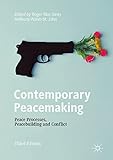Contemporary peacemaking peace processes, peacebuilding and conflict Authors:Roger Mac Ginty (Editor), Anthony Wanis-St John (Editor)
Contributor(s): Darby, John (John P.) | Mac Ginty, Roger.
©2022Description: xiii, 623 pages 23 cm.Content type: text Media type: unmediated Carrier type: volumeISBN: 9783030829612 (pbk. : alk. paper).Subject(s): Pacific settlement of international disputes | Peace | Peace processesGenre/Form: Print books.Summary: This fully updated third-edition of Contemporary Peacemaking is a state of the art overview of peacemaking in relation to contemporary civil wars. It examines best (and worst) practice in relation to peace processes and peace accords. The contributing authors are a mix of leading academics and practitioners with expert knowledge of a wide arrays of cases and techniques. The book provides a mix of theory and concept-building along with insights into ongoing cases of peace processes and post-accord peacebuilding. The chapters make clear that peacemaking is a dynamic field, with new practices in peacemaking techniques, changes to the international peace support architecture, and greater awareness of key issues such as gender and development after peace accords. The book is mindful of the intersection between top-down and bottom-up approaches to peace and how formal and institutionalized peace accords need to be lived and enacted by communities on the ground."-- Provided by publisher| Current location | Call number | Status | Date due | Barcode | Item holds |
|---|---|---|---|---|---|
| On Shelf | JZ6010 .C65 2022 (Browse shelf) | Available | AU00000000019985 |
Includes bibliographical references (p. 275-285) and index.
This fully updated third-edition of Contemporary Peacemaking is a state of the art overview of peacemaking in relation to contemporary civil wars. It examines best (and worst) practice in relation to peace processes and peace accords. The contributing authors are a mix of leading academics and practitioners with expert knowledge of a wide arrays of cases and techniques. The book provides a mix of theory and concept-building along with insights into ongoing cases of peace processes and post-accord peacebuilding. The chapters make clear that peacemaking is a dynamic field, with new practices in peacemaking techniques, changes to the international peace support architecture, and greater awareness of key issues such as gender and development after peace accords. The book is mindful of the intersection between top-down and bottom-up approaches to peace and how formal and institutionalized peace accords need to be lived and enacted by communities on the ground."-- Provided by publisher


